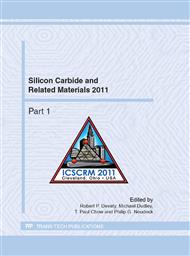[1]
P. Pirouz, M. Zhang, J.L. Demenet and H.M. Hobgood, Transition from brittleness to ductility in SiC, J. Phys.: Condens. Matter 14 (2002) 12929-12945.
DOI: 10.1088/0953-8984/14/48/335
Google Scholar
[2]
P. Pirouz, J.L. Demenet and M.H. Hong, On transition temperatures in the plasticity and fracture of semiconductors, Phil. Mag. A 81 (2001) 1207-1227.
DOI: 10.1080/01418610108214437
Google Scholar
[3]
A. Mussi, J. Rabier, L. Thilly and J.L. Demenet, Plasticity and deformation microstructure of 4H-SiC below the brittle-to-ductile transition, phys. stat. sol. (c) 4 (2007) 2929-2933.
DOI: 10.1002/pssc.200675438
Google Scholar
[4]
J.L. Demenet, X. Milhet and J. Rabier, TEM observations of the coexistence of perfect and dissociated dislocations in SiC under high stress, phys. stat. sol. (c) 202 (2005) 1987-1991.
DOI: 10.1002/pssc.200460541
Google Scholar
[5]
D. Cherns, A.R. Preston, Convergent beam diffraction studies of interfaces, defects, and multilayers, J. Electr. Microsc. Tech. 13 (1989) 111-122.
DOI: 10.1002/jemt.1060130204
Google Scholar
[6]
J.L. Demenet, M. Amer, C. Tromas and J. Rabier, to be published.
Google Scholar
[7]
T.F. Page, L. Riester, S.V. Hainsworth, The plasticity response of 6H-SiC and related materials to nanoindentation: slip vs densification, Mater. Res. Soc. Symp. Proc. 522 (1998) 113-118.
DOI: 10.1557/proc-522-113
Google Scholar
[8]
J. Rabier and J.L. Demenet, Low temperature, high stress plastic deformation of semiconductors: the silicon case, phys. stat. sol. (b) 222 (2000) 63-74.
DOI: 10.1002/1521-3951(200011)222:1<63::aid-pssb63>3.0.co;2-e
Google Scholar
[9]
B. Kedjar, L. Thilly, J.L. Demenet, J. Rabier, Plasticity of indium antimonide between -176°C and 400°C under hydrostatic pressure. Part II: Microscopic aspects of the deformation, Acta Mater. 58 (2010) 1426-1440.
DOI: 10.1016/j.actamat.2009.10.052
Google Scholar
[10]
M.H. Hong, A.V. Samant, and P. Pirouz, Stacking fault energy of 6H-SiC and 4H-SiC single crystals, Phil. Mag. A 80 (2000) 919-935.
DOI: 10.1080/014186100250615
Google Scholar
[11]
K. Maeda, K. Suzuki, S. Fujita, M. Ichihara and S. Hyodo, Defects in plastically deformed 6H-SiC single crystals studied by transmission electron microscopy, Phil. Mag. A 57 (1988) 573-592.
DOI: 10.1080/01418618808214408
Google Scholar
[12]
A. Mussi, J.L. Demenet and J. Rabier, TEM study of defects generated in 4H-SiC by microindentations on the prismatic plane, Phil. Mag. Lett. 86 (2006) 561-568.
DOI: 10.1080/09500830600930198
Google Scholar


